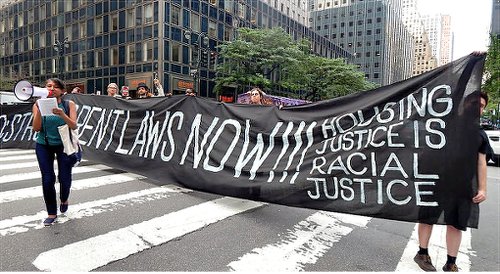



New York City is the largest city in the United States with an effective program to limit rents and defend the rights of tenants. This system has been under attack by landlords since it was established in the early 1940s.
On June 9, a coalition of tenant groups and unions brought hundreds of supporters of better rent laws to the Capitol in Albany for a day of protest.
New York Gov. Andrew Cuomo indicated that he did not want to risk the social eruption that would occur if billions of dollars were shifted from the pockets of tenants, mainly workers, to NYC landlords, some of the biggest real estate companies in the United States.
A letter from Cuomo to NYC landlords warned them not “to use a temporary lapse in the rent stabilization laws to break existing leases,” or to intimidate tenants or coerce them to leave their homes. (Daily News, June 14)
Cuomo will probably move for a weak extension of the current laws that have allowed landlords to remove 35,000 apartments from rent protections since 2011. Tenant groups estimate that 100,000 apartments are in danger of being flipped out of stabilization in the next year if the law is not strengthened.
Anecdotes abound about landlords offering thousands of dollars to tenants whose apartments can be deregulated to move out, while denying them services like heat and hot water.
New Yorkers face other crises
But the attack on rent stabilization is not the only crisis affecting the housing needs of poor and working people in New York City. There are more than 59,000 homeless people living in shelters, and those numbers are growing.
The 400,000 people in public housing run by the New York City Housing Authority are living in a system that has been allowed to deteriorate to such an extent that NYCHA estimates it needs about $15 billion to make repairs to roofs, elevators, boilers, plumbing and more to make its units livable.
One plan for resolving this lack of funds is to turn over large chunks of land devoted to public housing to private developers and use some of the funds the developers fork over for repairs. The details are in contention between NYC Mayor Bill de Blasio and Cuomo — but both of them support privatizing a large portion of public housing.
Another point of contention between Cuomo and de Blasio is the 421-A program, which gives developers substantial tax relief for creating “affordable” housing when they build market rate projects.
The “affordable” rents range from $800 a month for people earning over $28,000 a year in the South Bronx, one of the poorest neighborhoods in New York, to $2,800 a month in midtown Manhattan for people making $100,000 a year. In neither case would reasonable people consider such rents “affordable” — except the developers.
Housing, or shelter, like food and water is a basic human right that is being severely challenged in New York City. A movement is growing to defend this right.
Raposo is a Portuguese Marxist analyst, editor of the web magazine jornalmudardevida.net, where this article…
By Alireza Salehi The following commentary first appeared on the Iranian-based Press TV at tinyurl.com/53hdhskk.…
This is Part Two of a series based on a talk given at a national…
Educators for Palestine released the following news release on July 19, 2025. Washington, D.C. Educators…
On July 17, a court in France ordered the release of Georges Abdallah, a Lebanese…
The following are highlights from a speech given by Yemen’s Ansarallah Commander Sayyed Abdul-Malik Badr…